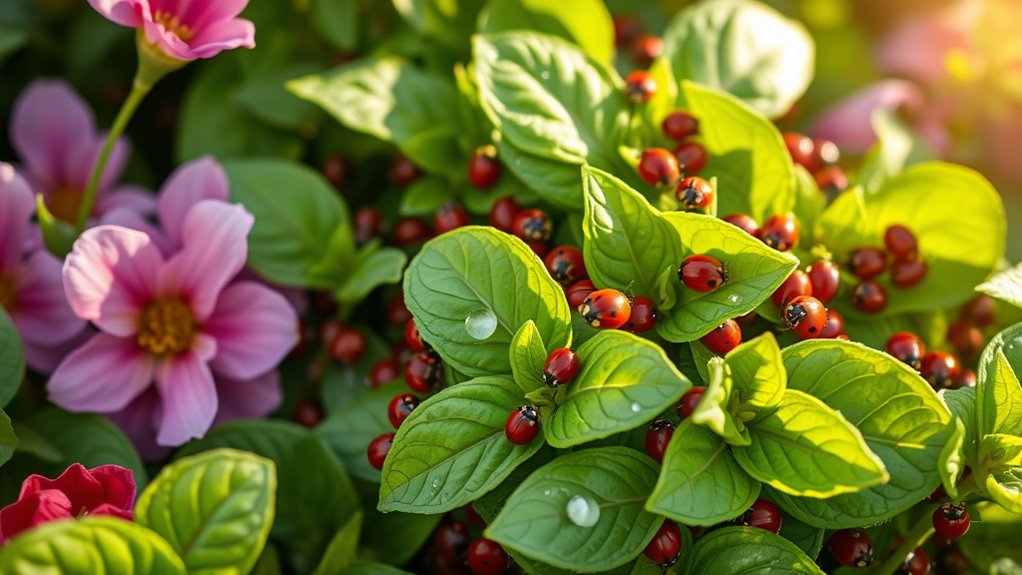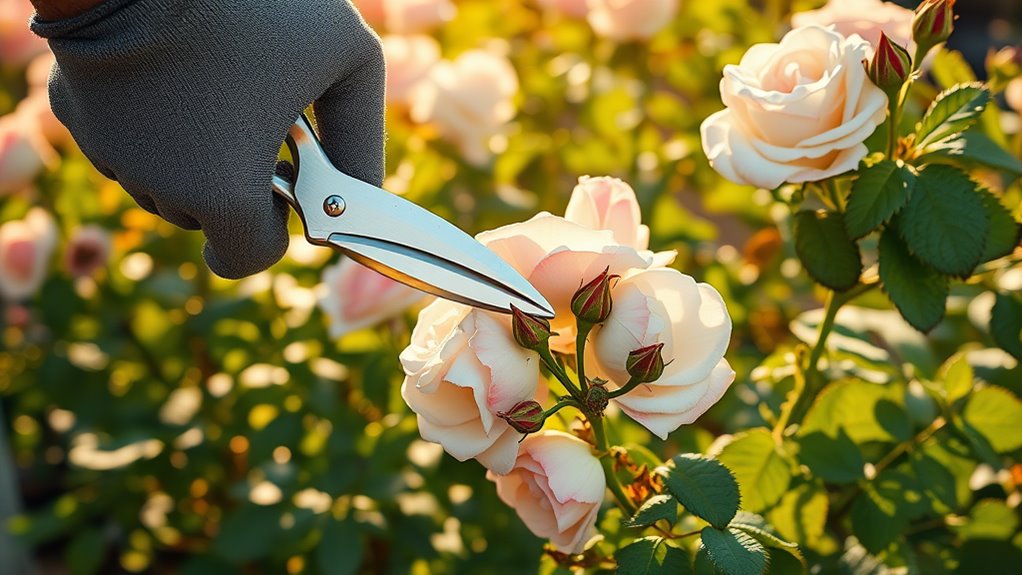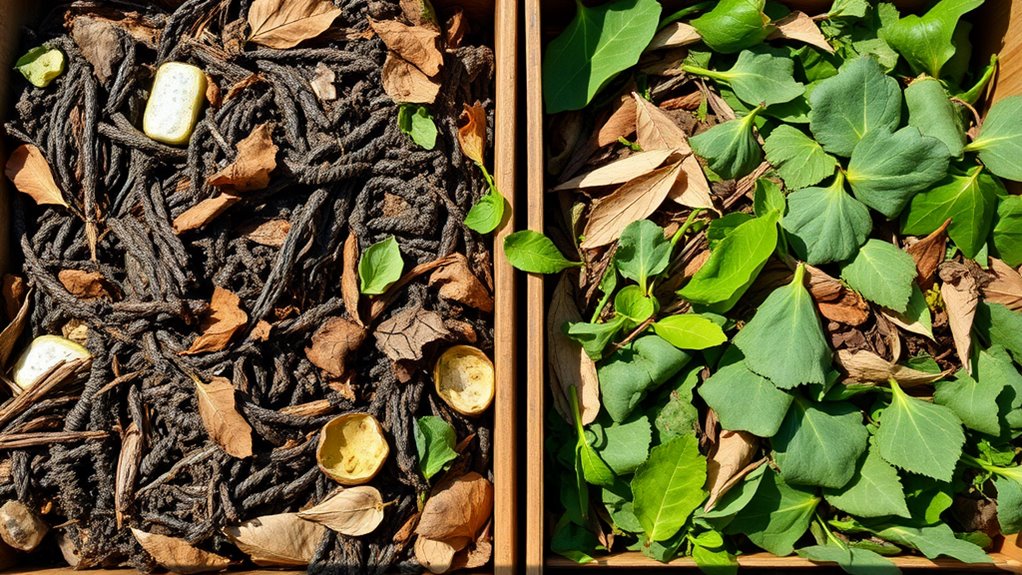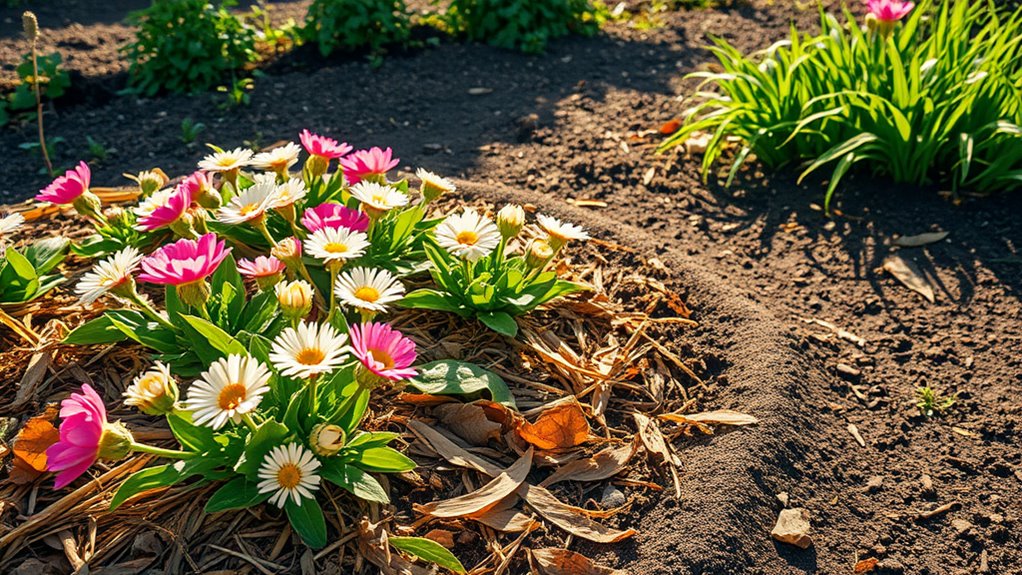The Secret to Pest-Free Plants Without Harsh Chemicals
You’ll identify pests early by inspecting leaves daily with a magnifying glass, spotting signs like holes or yellowing. Make DIY repellents like garlic spray or neem oil mixtures to deter aphids and chewing insects naturally. Attract beneficial bugs like ladybugs and use companion planting, such as marigolds with tomatoes, for a balanced defense. Craft homemade sprays and maintain sustainable habits like composting. These techniques pave the way for your garden’s ultimate resilience.
Key Takeaways
- Inspect plants daily for signs of pests like holes or yellowing to catch issues early.
- Use garlic spray made from crushed cloves to repel aphids and other insects naturally.
- Introduce beneficial insects like ladybugs to control pests while maintaining garden balance.
- Apply diluted neem oil mixtures as a protective barrier against chewing pests.
- Enrich soil through composting to foster resilient plants that resist pest infestations.
Natural Pest Identification Methods
How can you identify pests on your plants using natural methods? Start by inspecting leaves and stems daily for signs like holes, yellowing, or sticky residues, which often signal aphids or mites.
In natural pest control, you observe plant health closely—wilting or distorted growth can indicate hidden insects. Use a magnifying glass to spot tiny pests without chemicals, and note patterns in a journal. To complement this, consider incorporating natural herbs into your pest management routine.
This proactive approach helps you detect issues early, relying on visual and tactile checks for precise, science-based monitoring. Remember, accurate identification prevents unnecessary interventions.
Additionally, learning about the top five pests commonly affecting gardens can enhance your ability to recognize and address infestations promptly.
DIY Organic Repellents for Plants
DIY organic repellents offer a simple, effective way to shield your plants from pests using natural ingredients like garlic, neem oil, and herbs. These methods also support healthy garden ecosystems by minimizing environmental impact.
You’ll mix these everyday items into sprays that disrupt pests’ senses without harming your garden’s ecosystem.
-
Garlic Spray: Crush garlic cloves and steep in water; this releases allicin, a compound that repels aphids by overwhelming their olfactory receptors, creating a pungent barrier around your leaves.
-
Neem Oil Mixture: Dilute neem oil in soapy water; its azadirachtin deters chewing insects like caterpillars, forming a protective film that makes foliage unappetizing.
-
Herbal Infusion: Brew peppermint or chili peppers into a tea; capsaicin and menthol irritate pests’ mouthparts, evoking a fiery sensation that drives them away from your plants.
These repellents align with unconventional remedies for effective natural pest control.
Beneficial Insects as Allies
You can use beneficial insects like ladybugs and lacewings to naturally control pests such as aphids and mites in your garden.
These insects target specific threats, helping maintain a balanced ecosystem without chemicals.
Now, let’s explore how you attract these helpful bugs to boost your plant’s defenses. Additionally, incorporating easily accessible staples can further support a healthy garden ecosystem.
Embracing natural DIY techniques allows you to attract these insects effectively without any financial investment.
Insect Types Explained
Beneficial insects act as nature’s defenders, helping protect your plants from pests without relying on chemicals. These allies, including predators and parasitoids, naturally boost your garden’s ecosystem by preying on harmful bugs while promoting biodiversity.
-
Ladybugs: Picture these vibrant, spotted beetles scurrying across your leaves, their glossy red shells glinting as they methodically consume aphids in a feeding frenzy.
-
Lacewings: Imagine delicate, emerald-green insects with intricate, netted wings hovering near your plants, where their voracious larvae ambush and devour soft-bodied pests.
-
Parasitoid wasps: Envision tiny, slender wasps patrolling your garden, their slender bodies and antennae guiding them to lay eggs inside host insects, ensuring precise biological control.
Pests They Control
These natural predators tackle a range of common garden pests, ensuring plants thrive without chemical intervention.
You’ll see ladybugs devouring aphids and mealybugs, keeping your foliage healthy.
Lacewings actively hunt mites and thrips, preventing outbreaks that damage leaves.
Ground beetles patrol for caterpillars and slugs, reducing the need for sprays.
Parasitoid wasps lay eggs in pest larvae, like those of moths and flies, naturally controlling populations.
Attracting Garden Bugs
Attracting beneficial insects to your garden starts with fostering the right habitat, where they can flourish and naturally manage pests. You’ll enhance biodiversity by selecting plants that offer nectar, pollen, and shelter, turning your space into a thriving ecosystem that keeps harmful bugs in check.
-
Visualize flowering herbs like dill and fennel swaying gently, drawing ladybugs that feast on aphids, creating a vibrant mosaic of red and black defenders.
-
Picture clusters of wildflowers such as alyssum blooming profusely, attracting lacewings with their delicate wings to patrol and eliminate pest larvae.
-
Envision a mulch-layered border with native grasses, providing cozy nooks for parasitic wasps that stealthily hunt caterpillars, ensuring a balanced, pest-resistant garden.
Companion Planting Techniques
You can pair ideal plants like marigolds with tomatoes to naturally repel pests through their emitted compounds.
This method draws on scientific observations of how certain plants interfere with insect behaviors or attract predators. Moreover, these strategies can increase crop yields while enhancing garden health through effective plant pairings.
This approach also leverages specific plant combinations to enhance overall growth and health.
Ideal Plant Pairs
Companion planting offers strategic plant pairings that boost natural pest resistance and garden health. You can enhance your garden by selecting plants that complement each other’s growth, creating a balanced ecosystem.
These pairs deter pests through natural synergies while promoting vigor.
-
Tomatoes and basil: Imagine vibrant basil leaves surrounding robust tomato vines, their aromatic oils repelling unwanted insects while enhancing flavor profiles.
-
Marigolds and peppers: Picture golden marigold blooms guarding pepper plants, their roots releasing compounds that naturally ward off nematodes in the soil.
-
Beans and corn: Envision tall corn stalks supporting climbing bean vines, their nitrogen-fixing abilities enriching the soil for mutual thriving.
Natural Pest Defense
While pests threaten garden vitality, strategic companion planting techniques harness natural defenses to protect your plants effectively.
In companion planting, you pair marigolds with tomatoes to repel nematodes via root-secreted compounds that disrupt pest life cycles. You deter aphids by placing basil near beans, as its essential oils emit volatile signals that confuse insects.
Interplant onions among carrots to create olfactory confusion, masking scents pests detect. These scientifically proven methods leverage plant chemistry and ecological interactions for sustainable control.
Start small: observe and adjust pairings based on your garden’s specific conditions for optimal results.
Homemade Natural Sprays and Solutions
To maintain pest-free plants without harsh chemicals, you can whip up homemade sprays using simple ingredients like garlic, soap, or neem oil. These DIY mixtures leverage natural properties to deter pests scientifically, ensuring your garden thrives without synthetic risks, and they’re simple to make at home. Moreover, these natural solutions promote biodiversity by supporting beneficial insects in the ecosystem.
-
Imagine blending fresh garlic cloves with water, straining the mixture, and spraying it on your plant leaves; the pungent aroma naturally repels aphids and other insects by overwhelming their senses.
-
Picture mixing a few drops of mild liquid soap into water; when you spray this on infested areas, it coats and suffocates soft-bodied pests like mites, disrupting their protective layers.
-
Visualize diluting neem oil in water and applying it; this solution interferes with pests’ feeding and reproduction cycles, offering effective, long-lasting control while preserving beneficial insects.
This DIY pest spray is effective for maintaining a healthy garden while minimizing chemical use.
Sustainable Garden Maintenance Practices
Beyond homemade sprays, you integrate sustainable maintenance practices into your routine to foster a thriving, eco-friendly garden.
Start with mulching; it suppresses weeds, retains soil moisture, and enhances microbial activity, reducing pest habitats.
Practice crop rotation to disrupt pest cycles and maintain soil nutrients naturally.
Implement companion planting, where marigolds deter nematodes and basil repels aphids through scientifically proven allelopathy.
Additionally, basil and tomato pairing can enhance growth, flavor, and pest resistance in your garden.
Through my first experience with companion planting, I discovered surprising results that included increased yields and reduced pest issues.
Regularly monitor plants for early signs of infestation, removing pests manually to minimize outbreaks.
Compost organic waste to enrich soil, promoting resilient plant growth without synthetic inputs.
These methods ensure long-term ecological balance.





